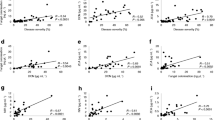Abstract
Forty Fusarium isolates obtained from maize fields were screened for moniliformin production on maize kernels. Twelve isolates, including seven of F. subglutinans, were found to produce moniliformin at levels ranging from 0.4 to 64 ppm. Twenty six isolates were also screened for production of deoxynivalenol, diacetoxyscirpenol, T-2 toxin and zearalenone. Of these, 22, including all 11 isolates of F. graminearum, produced zearalenone at levels ranging from 0.1 to 96.0 ppm, while 13 produced T-2 toxin at low levels, (<1.1 ppm). Deoxynivalenol and diacetoxyscirpenol were each produced by six isolates, also at low levels (<1.0 ppm). Three isolates of F. graminearum and one of F. sambucinum produced four toxins simultaneously.
Similar content being viewed by others
References
Agnew MP, Poole PR, Lauren DR, Ledgard SF. Presence of zearalenone and trichothecene mycotoxins in Fusarium-infected New Zealand grown wheat. NZ Vet J 1986; 34: 176–7.
Blaney BJ, Moore CJ, Tyler AL. Mycotoxins and fungal damage in maize harvested during 1982 in far north Queensland. Aust J Agric Res 1984; 35: 463–71.
Bottalico A, Lerario P, Visconti A. Production of zearalenone, trichothecenes and moniliformin by Fusarium species from cereals, in Italy. In: H Kurata and Y Ueno (eds) Toxigenic fungi-their toxins and health hazard. Amsterdam: Elsevier, 1984; 199–208.
Burgess LW, Liddell CM. Laboratory manual for Fusarium Research. University of Sydney, Sydney, 1983.
Fisher NL, Burgess LW, Toussoun TA, Nelson PE. Carnation leaves as a substrate and for preserving cultures of Fusarium species. Phytopathology 1982; 72: 151–2.
Gallagher RT. On the oestrogenic mycotoxin zearalenone and the pasture fungus Fusarium culmorum. NZ Vet J 1985; 33: 37–8.
Gilbert J. The detection and analysis of Fusarium mycotoxins. In: Moss, MO and Smith, JE, eds. The applied mycology of Fusarium. Cambridge: Cambridge University Press, 1984; 175–93.
Gilbert J, Shepherd MJ, Startin JR. The analysis and occurrence of Fusarium mycotoxins in the United Kingdom and their fate during food processing. In: Kurata, H and Ueno, Y, eds. Toxigenic fungi-their toxins and health hazard. Amsterdam: Elsevier, 1984; 209–16.
Hussein HM, Baxter M, Andrew IG, Franich RA. Fusarium mycotoxins in New Zealand maize. NZ Vet J 1987; 35: 155.
Hussein HM, Franich RA, Baxter M, Andrew IG. Naturally occurring Fusarium toxins in New Zealand maize. Food Adds Cont 1989; 6: 49–58.
Ichinoe M, Kurata H. Trichothecene-producing fungi. In: Ueno, Y, ed. Trichothecenes-chemical, biological and toxicological aspects. Amsterdam: Elsevier, 1983; 73–82.
Kamimura H, Nishijima MY, Tasuda K, Saito K, Ibe A, Nagayama T, Ushiyama H, Naoi Y. Simultaneous detection of several Fusarium mycotoxins in cereals, grains and foodstuffs. J Assoc Off Anal Chem 1981; 64: 1067–73.
Kriek NPJ, Marasas WFO, Steyn PS, Van Rensburg SJ, Steyn M. Toxicity of moniliformin-producing strain of Fusarium moniliforme var. subglutinans isolated from maize. Food Cosmet Toxicol 1977; 579–87.
Marasas WFO, Kellerman TS, Gelderblom WCA, Coetzer PG, Thiel PG, Van der Lugt JJ. Leukoencephalomalacia in a horse induced by fumonisin B isolated from Fusarium moniliforme. Onderstepoort J Vet Res 1988; 55: 197–203.
Marasas WFO, Kriek NPJ, Wiggins VM, Steyn PS, Towers DK, Hastie TJ. Incidence, geographic distribution and toxigenicity of Fusarium species in South African corn. Phytopathology 1979; 69: 1181–5.
Marasas WFO, Nelson PE, Toussoun TA. Toxigenic Fusarium species. Identity and mycotoxicology. University Park, Penn.: The Pennsylvania State University Press, 1984.
Miller JP, Greenhalgh R. Nutrient effects on the biosynthesis of trichothecenes and other metabolites by Fusarium graminearum. Mycologia 1985; 77: 130–6.
Mirocha CJ. Mycotoxicoses associated with Fusarium. In: Moss, MO and Smith, JE, eds. The applied mycology of Fusarium. Cambridge: Cambridge University Press, 1984; 141–55.
Neish GA, Farnworth ER, Cohen H. Zearalenone and trichothecene production by some Fusarium species associated with Canadian grains. Can J Plant Pathol 1982; 4: 191–4.
Pier AC. Mycotoxins and animal health. Adv Vet Sci Comp Med 1981; 25: 185–243.
Rabie CJ, Marasas WFO, Thiel PG, Lubben A, Vleggaar R. Moniliformin production and toxicity of different Fusarium species from Southern Africa. Appl Envir Microbiol 1982; 43: 517–21.
Rabie CJ, Sydenham EW, Thiel PG, Lubben A, Marasas WFO. T-2 toxin production by Fusarium acuminatum isolated from oats and barley. Appl Envir Microbiol 1986; 52: 564–9.
Richardson KE, Hagler WM, Campbell CL, Hamilton PB. Production of zearalenone, T-2 toxin, and deoxynialenol by Fusarium species isolated from plant materials grown in North Carolina. Mycopathologia 1985; 90: 155–60.
Scott PM, Abbas HK, Mirocha CJ, Lawrence GA, Weber D. Formation of moniliformin by Fusarium sporotrichioides and Fusarium culmorum. Appl Envir Microbiol 1987; 53: 196–7.
Shepherd MJ and Gilbert J. Method for the analysis in maize of Fusarium mycotoxin moniliformin employing ion-pairing extraction and high-performance liquid chromatography. J Chromatogr 1986; 358: 415–22.
Thiel PG, Gelderblom WCA, Marasas WFO, Nelson PE, Wilson TM. Natural occurrence of moniliformin and fusarin C in corn screenings known to be hepatocarcinogenic in rats. J Agric Food Chem 1986; 34: 773–5.
Thrane U. Detection of toxigenic Fusarium isolates by thin layer chromatography. Lett Appl Microbiol 1986; 3: 93–6.
Ueno Y. Trichothecenes-chemical, biological and toxicological aspects. Elsevier, Amsterdam, 1983.
Vesonder RF, Ciegler A, Jensen AH, Rohwedder WK, Weisleder D. Co-identity of the refusal and emetic principle from Fusarium-infected corn. App Envir Microbiol 1976; 31: 280–5.
Vesonder RF. Moniliformin produced by cultures of Fusarium moniliforme var subglutinans isolated from swine feed. Mycopathologia 1986; 95: 149–53.
Wilson TM, Nelson PE, Ryan TB, Rouse CD, Pittman CW, Neal TP, Porterfield ML, Saunders GK. Linking leukoencephalomalacia to commercial horse rations. Vet Med 1985; 80: 63–9.
Author information
Authors and Affiliations
Rights and permissions
About this article
Cite this article
Hussein, H.M., Baxter, M., Andrew, I.G. et al. Mycotoxin production by Fusarium species isolated from New Zealand maize fields. Mycopathologia 113, 35–40 (1991). https://doi.org/10.1007/BF00436385
Received:
Accepted:
Issue Date:
DOI: https://doi.org/10.1007/BF00436385




